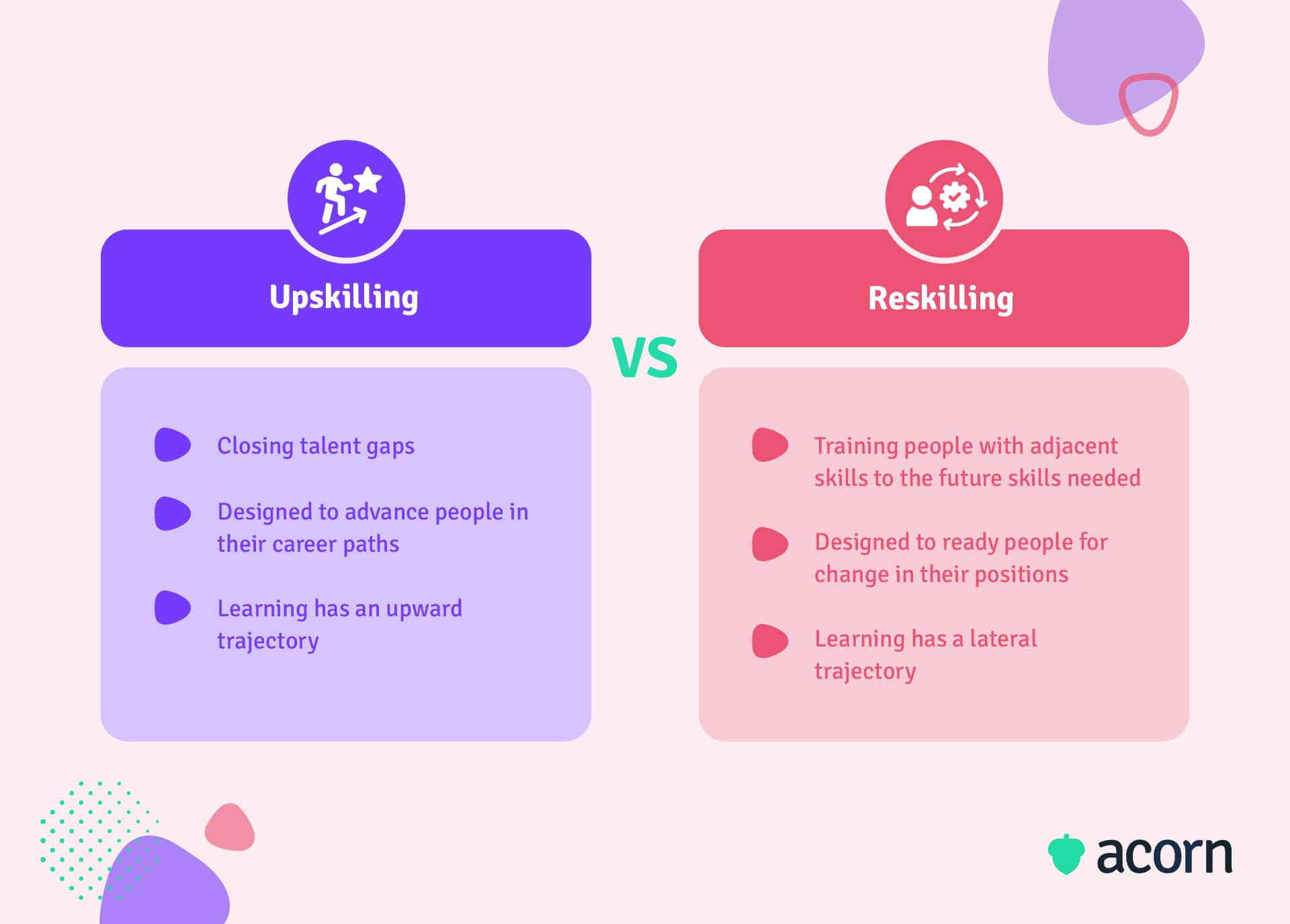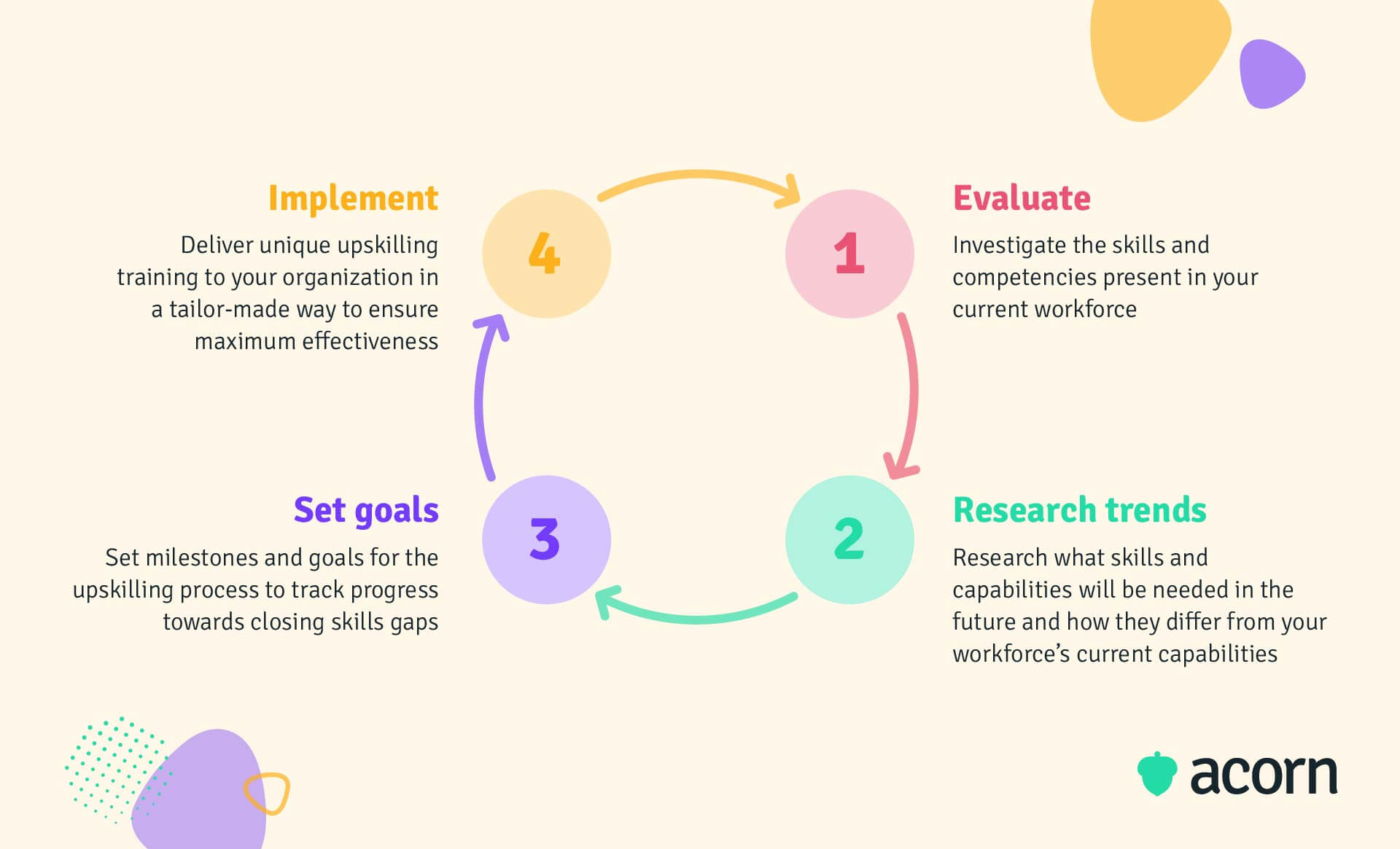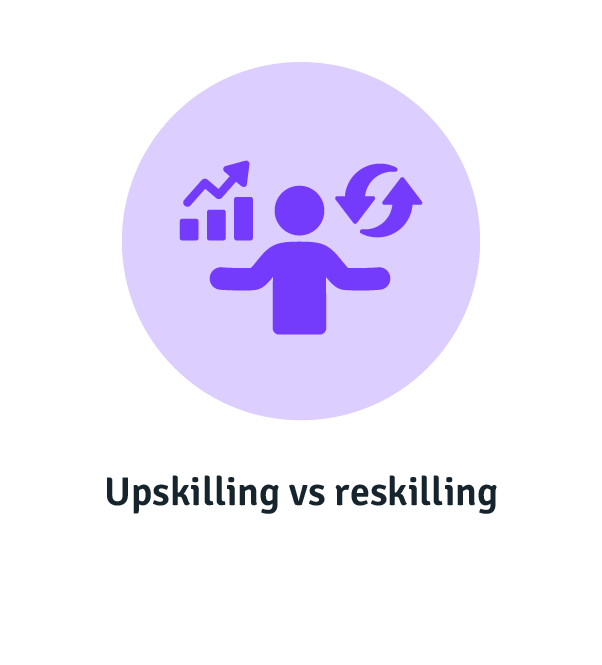We live in a digital world, and that means businesses and technology are changing as a result. With shifts in digital technology come shifts to in-demand skills, and if you don’t keep abreast of the industry trends, you’ll be left behind. To keep your workforce from falling victim to skills attrition, you’ll want to provide your employees with upskilling training.
But what is upskilling, and how does it really help your organisation? We’ll dive into the importance of upskilling for your business success.
What is upskilling?
Upskilling is the process of closing talent and skills gaps within your organisation. It’s about giving your employees training and development opportunities to build their skills, abilities and capabilities by improving on their current skillsets.
Is upskilling the same as reskilling?
The short answer? No.
While the processes to upskill or reskill employees both involve training, the key difference between them lies in their objectives. The simple definitions are:
- Upskilling is learning new skills or teaching new skills to employees to improve their performance.
- Reskilling is the process of teaching or learning new skills so you can perform a different job.

What are the benefits of upskilling employees in a business?
Organisations don’t exist in a vacuum. The global workforce is currently undergoing a digital transformation, driving change in industry trends and how businesses operate. In the future there were will be new shifts and new technologies affecting organisations. This is all to say that regardless of what is currently standard in your industry, inevitable change—because yes, it is inevitable—will affect what skills and capabilities are needed to keep up.
This is why at Acorn, we’ve developed the first performance learning management system (PLMS). It’s a dynamic AI-powered tool designed to codify and operationalise capabilities to improve organisational efficiency as your company scales, linking learning experiences to business performance.
Fills skills gaps
You can always hire new talent to close the skills gap, but the cost of finding someone with the right skills, hiring them, and onboarding them to your company will be high, both financially and timewise. Alternatively, you can focus on upskilling training for your current employees, building their understanding (which they already have of your systems, processes and company mission) with the relevant, sought-after skills.
Employee retention
In this day and age, workers want employers that take an active interest in their professional development, with up to 94% of employees saying they would stay with a company longer if it invested in their growth. Plus, with advances in technology comes a need for more (and new) technical skills. Your workers know they need to keep up to date with the latest in-demand skills to keep their future employment prospects open.
Attract new hires
Considering employees can be retained for longer when provided with training courses to drive their own development, it tracks that you’ll attract more new hires, too. Potential candidates are more likely to find your business attractive if it’s known to upskill employees and arm them with the relevant skills to maintain a competitive advantage in the workforce.
Employee satisfaction
A McKinsey study found 40% of employees are planning to leave their organisations for positions that are better paying or more satisfying. Changes in the industry move fast, and so does job outlook, so employees want to feel they’re in the best position to face that. Providing upskilling training to your employees tells them that you value their work and their place within your current workforce.
Increased productivity
When your employees are equipped with the right skills and tools to carry out their jobs, they’ll be able to complete their responsibilities more efficiently, freeing up time for other activities that will add value to your business. Plus, if you upskill your current employees in the digital tools that automate repetitive or menial daily tasks, productivity will get a boost.
Strengthens your business
When you provide upskilling training, you create a workforce equipped for the future—it’s just good change management. We don’t realise how vulnerable we or our organisations are to abrupt (or sometimes even obvious) change until it happens, but the fact is you’ll be worse off if your company was already lagging behind the pack.
Look at upskilling your employees as an exercise in future-proofing your organisation by arming them with the workplace skills of the future. You can research trends in the industry and develop the skillset of your company to meet change head-on. If the change is something you predicted, your company will be ahead of the curve while others struggle to adjust. But if the change is unexpected, your company will fare better with employees versed in the latest skills and capabilities who can adapt quickly to the new environment.
Culture of learning
This one is a bit of a paradox. You want your employees to be engaged in their training, because that creates a learning culture. And in a learning culture, managers also act as coaches, providing on-the-job training and advice to their subordinates. This, in turn, leads to a workplace in which managers coach team members and drive engagement in learning. You can see the cycle. It’s a continuous effort to learn and encourage others to learn.
Happier customers
Customers will notice the impacts improved cultures and workplace productivity have on services and products. With an improvement in culture and workplace productivity, how could customers not notice? When business leaders focus on upskilling training and career progression, company morale increases along with productivity. Customers and clients want to work with a company that clearly knows what it’s doing, and if your customers can see that in your organisation then you’ll see a boost to customer satisfaction.
Upskilling pitfalls to avoid
Sometimes upskilling just doesn’t work out the way you want. This could be because of a lack of proper strategising and planning, or even just poor execution. There are a few risks you should be aware of to try and avoid when delivering upskilling.
Not tailoring your training to the individual employees
It’s certainly easy to assign the same learning across your organisation, but is it actually helpful? For many, generalised training may not be relevant to them or their career, causing them to disengage from the material. If it’s information or training they’ve already received, forcing them to participate will have been a waste of both time and money for everyone.
The workaround is strategic training and development—i.e. learning activities that directly target skills gaps. Consider vocational education; it covers specific skills for optimal performance in a certain role. Training with a purpose is more engaging for employees since not only can they see long-term career growth, but experience immediate performance improvements. You can do this with a survey or skills matrix to assess what skills need to be developed and how interested employees are in them. Once you’ve evaluated this, you’ll be able to tailor your training to develop critical skills and plug knowledge and capability gaps.
Only offering training as a one-off
The crucial aspect to remember about industry changes is that the changes never stop. While one-off training may be up to date at the time of its delivery, it won’t help an employee gain a working understanding of the competencies they need for their career. Understanding of a topic or practice takes time to develop, so it goes without saying that one-time courses won’t help training stick.
Your upskilling strategy should consist of continuous learning to help the retention of knowledge, otherwise your workforce will be ill-equipped for the future.
Providing antiquated training
In this day and age, learning needs to be convenient and engaging. Unfortunately, traditional learning methods—such as in-person classes or presentations—don’t really fit with that anymore. Instead, you should embrace newer, more streamlined training methods that provide tailored learning experiences. Consider:
- Stretch assignments
- Capability development plans
- Succession training and job shadowing.
Don’t knock face-to-face or face-to-screen methods entirely, either. Workshops and networking events are particularly good for leadership development, as they allow for real-time feedback and discussions with like-minded professionals.
How to upskill your workforce

So how to you actually get started with upskilling? Let’s take a look at the five steps to developing your upskilling strategy:
- Evaluate
- Research trends
- Set goals
- Implement
- Evaluate again.
Step 1: Evaluate
This is where the skills matrix and evaluation we mentioned above comes in. Evaluate your workforce: What skills and competencies do you have and which employees have them? Take a note as well of employees who are willing to learn more and what improvements or developments they want to make to their capabilities.
Step 2: Research trends
Take a moment to look at where your industry is headed. What skills will be necessary for an organisation in the future? Don’t just look at what may be possible in the next couple of years, but also what’s likely to be in demand in a decade. How does this differ from your current employees’ capabilities, and what will have to change in order to close the gap?
Step 3: Set goals
This is important. Make sure you communicate clear goals to your team about expectations for their upskilling training. It’s important to set not just the final goal (which may be several years down the line) but also smaller milestones in the interim. This way you’ll be able to follow your team’s progress and make sure your upskilling training is on track.
Step 4: Implement
This is the part where you actually deliver upskilling to your organisation. First, you need to decide your rollout method. Some organisations are content to roll out their training programs business-wide, but for bigger companies, such a grand endeavour could spell disaster. Limiting your upskilling training to a few departments and skills at a time may be more effective for you. Just like the training itself, this implementation process needs to be tailored to your specific organisation and its needs.
Next, think on how you plan to deliver your training. You could have some of your own people running the training, or you might hire external training providers if that’s more convenient for you. Again, be sure to tailor, tailor, tailor. If your workforce is largely remote, providing eLearning training will be the way to go. But if all your staff are in one central location, it might be easier to use other, hands-on methods.
eLearning
This is simple, cost effective and convenient, and you can use a learning management system (LMS) to make the process easier. With eLearning you give your employees access to training courses from wherever they are, to be completed at their own pace. Some LMSs come with mobile learning apps, making them an effective way of delivering upskilling training in bite-sized short courses.
Mentoring
We learn and perform better when we have practice at it, so it goes without saying that mentoring is a great way to increase learner engagement and information retention. Pairing a more experienced employee with a less experienced one will allow the more experienced employee to provide guidance and skills.
They can also impart unique knowledge that comes from personal experience–i.e. the kind of knowledge that can’t be translated to the page, because it can only be learned by doing.
Step 5: Evaluate again
You can’t just set and forget. While you may be ready for the world in five years’ time, there’s another five years after that in which everything will change again. Start with monitoring the progress and effectiveness of your upskilling training so far and ask if anything needs to be tweaked or adjusted in your strategy.
The points you assess should show a clear impact on your organisation’s performance. An effective upskilling program should:
- Improve business performance
- Improve employee performance
- Instil the skills and capabilities required for employees to carry out their jobs.
Then, of course, think about the future. New technologies and methods are constantly being developed. You need to work to make sure your company is flexible enough to take on whatever the future brings.
Key takeaways
Upskilling is a crucial step in ensuring the flexibility and sustainability of your organisation. Not only will it create a healthier and more productive business, but it will give your organisation greater resilience in the face of unexpected change. It’s the difference between forging the path ahead and struggling to adapt.
Just like with any process designed to develop your workforce, upskilling isn’t some activity you can do once and the forget about. You need to continuously work on it to ensure consistent results.
Related Reads on This Topic

The Value of Developing Leadership Skills in the Workplace (and Best Practices)
Developing leadership skills is valuable to not only employees, but also your company. Find out why and what the best practices are…

How to Develop a Learning and Development Strategy for Impactful Employee Training
An effective learning and development strategy fosters professional growth and upskilling. Find out how this can reshape your business today…

Just Why Do Businesses Care About a Learning and Development Strategy Framework?
Businesses are adopting a learning and development strategy framework. Find out why and how an L&D strategy framework can help your business…





